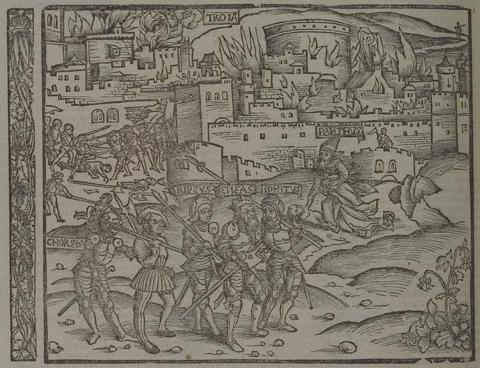Annotations
In the middle right, Panthus, the priest of Apollo runs carrying sacred objects in his hand and dragging a young boy, his grandson, along the ground (318-21). According to Vergil, he runs to the house of Aeneas, to announce that the Greeks are attacking and destroying the city (323-35). In the foreground, Aeneas, Coroebus [Chorebs], Ripheus [Ripeus], and Epytus [Iphitus], set out to fight the Greeks (339-42). In the middle ground, on the left, a crowd of soldiers is seen fighting one another with spears. In the background, the city of Troy burns (352), and a few diminutive figures hold out their arms in distress. In the lower right corner, a drooping flower is quite prominent. (Katy Purington)
Woodcut illustration from the “Strasbourg Vergil,” edited by Sebastian Brant: Publii Virgilii Maronis Opera cum quinque vulgatis commentariis expolitissimisque figuris atque imaginibus nuper per Sebastianum Brant superadditis (Strasbourg: Johannis Grieninger, 1502), fol. 168v, executed by an anonymous engraver under the direction of Brant.


Sebastian Brant (1458–1521) was a humanist scholar of many competencies. Trained in classics and law at the University of Basel, Brant later lectured in jurisprudence there and practiced law in his native city of Strasbourg. While his satirical poem Das Narrenschiff won him considerable standing as a writer, his role in the transmission of Virgil to the Renaissance was at least as important. In 1502 he and Strasbourg printer Johannes Grüninger produced a major edition of Virgil’s works, along with Donatus’ Life and the commentaries of Servius, Landino, and Calderini, with more than two hundred woodcut illustrations. (Annabel Patterson)